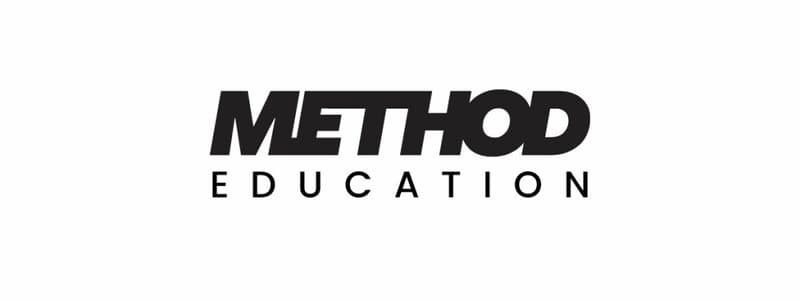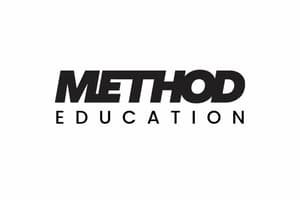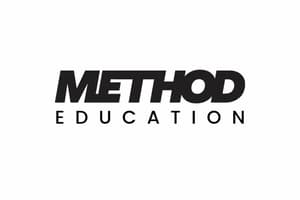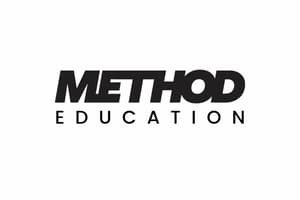Podcast
Questions and Answers
Why is the ability to visually recognize faults in movement mechanics crucial for a trainer?
Why is the ability to visually recognize faults in movement mechanics crucial for a trainer?
- It enables the trainer to impress clients with their keen observational skills, enhancing client retention.
- It allows the trainer to immediately correct the athlete's form without needing to understand the underlying biomechanics.
- It is the foundational step necessary for a trainer to facilitate positive changes in a client's mechanics. (correct)
- It provides a basis for billing clients for detailed movement analysis, increasing revenue.
Which of the following exemplifies a scenario where identifying static faults is advantageous for trainers assessing an athlete's movement?
Which of the following exemplifies a scenario where identifying static faults is advantageous for trainers assessing an athlete's movement?
- Assessing the athlete's upper body strength during a series of rapid-fire push-ups.
- Analyzing the athlete's stability and alignment in the setup position of a deadlift. (correct)
- Evaluating the athlete's cardiovascular endurance during a high-intensity interval training session.
- Observing the athlete's agility during a plyometric box jump, focusing on speed and reactivity.
What is the MOST effective viewing angle for assessing an athlete’s overall movement mechanics, and why?
What is the MOST effective viewing angle for assessing an athlete’s overall movement mechanics, and why?
- A profile view offset by approximately 45 degrees, which allows for simultaneous evaluation of multiple relationships like trunk-to-femur and bar path. (correct)
- A direct rear view, enabling detailed analysis of spinal alignment and posterior chain engagement.
- A direct frontal view, because it allows assessment of bilateral symmetry and balance.
- A bird's-eye view, because it provides a comprehensive overview of spatial awareness and coordination.
Which scenario poses the greatest challenge in identifying dynamic faults, requiring heightened observational skills from the trainer?
Which scenario poses the greatest challenge in identifying dynamic faults, requiring heightened observational skills from the trainer?
A trainer observes an athlete during a push jerk. Which of the following requires the most comprehensive simultaneous evaluation to ensure correct form?
A trainer observes an athlete during a push jerk. Which of the following requires the most comprehensive simultaneous evaluation to ensure correct form?
Why is the ability to prioritize faults (triage) crucial in correcting an athlete's mechanics?
Why is the ability to prioritize faults (triage) crucial in correcting an athlete's mechanics?
How does a trainer's capacity in teaching and seeing directly impact their ability to correct an athlete's mechanics?
How does a trainer's capacity in teaching and seeing directly impact their ability to correct an athlete's mechanics?
What is the MOST significant outcome of effectively correcting an athlete's mechanics?
What is the MOST significant outcome of effectively correcting an athlete's mechanics?
Why might a new trainer find it beneficial to initially focus on observing only one specific fault at a time when assessing an athlete's movement?
Why might a new trainer find it beneficial to initially focus on observing only one specific fault at a time when assessing an athlete's movement?
How can the use of film, viewed in both slow motion and real-time, aid in the development of a trainer's ability to identify dynamic faults?
How can the use of film, viewed in both slow motion and real-time, aid in the development of a trainer's ability to identify dynamic faults?
What is the BEST way to improve at observing multiple faults simultaneously?
What is the BEST way to improve at observing multiple faults simultaneously?
Which of the following strategies would be the LEAST effective for a new trainer trying to improve their ability to 'see' dynamic faults in athletes?
Which of the following strategies would be the LEAST effective for a new trainer trying to improve their ability to 'see' dynamic faults in athletes?
Why should a trainer avoid merely 'OK' movement in athletes?
Why should a trainer avoid merely 'OK' movement in athletes?
A trainer notices an athlete's knees are caving in during a squat. Which cue would be MOST effective?
A trainer notices an athlete's knees are caving in during a squat. Which cue would be MOST effective?
How does a trainer's ability to correct faulty movement hinge on the trainer
How does a trainer's ability to correct faulty movement hinge on the trainer
What is MOST important when determining the value of a cue?
What is MOST important when determining the value of a cue?
Why do short, specific, and actionable cues tend to have a greater success rate?
Why do short, specific, and actionable cues tend to have a greater success rate?
What is the PRIMARY purpose of a cue in athletic training?
What is the PRIMARY purpose of a cue in athletic training?
Which coaching strategy is MOST effective for promoting long-term athletic improvement?
Which coaching strategy is MOST effective for promoting long-term athletic improvement?
An athlete is struggling to maintain proper foot pressure during a squat. Which cue is MOST likely to produce the desired result?
An athlete is struggling to maintain proper foot pressure during a squat. Which cue is MOST likely to produce the desired result?
What is the difference between identifying a fault and providing a cue?
What is the difference between identifying a fault and providing a cue?
Why might a trainer's use of technical language, such as "You are losing your midline," be considered a less effective cue?
Why might a trainer's use of technical language, such as "You are losing your midline," be considered a less effective cue?
Which statement explains why non-specific cues like "Get tight!" are often ineffective for athletes?
Which statement explains why non-specific cues like "Get tight!" are often ineffective for athletes?
Which of the following reflects the most effective application of actionable feedback in athletic training?
Which of the following reflects the most effective application of actionable feedback in athletic training?
What is the primary role of a trainer in translating fault identification into specific corrective actions for an athlete?
What is the primary role of a trainer in translating fault identification into specific corrective actions for an athlete?
When creating cues for athletes, why is it important to avoid overly complex or technical language?
When creating cues for athletes, why is it important to avoid overly complex or technical language?
In the context of athletic training, why is specificity in verbal cues considered more effective than general cues?
In the context of athletic training, why is specificity in verbal cues considered more effective than general cues?
What is the MOST LIKELY pitfall of using cues like "Chest!" without further explanation?
What is the MOST LIKELY pitfall of using cues like "Chest!" without further explanation?
What does it mean for a cue to be 'actionable' in athletic training?
What does it mean for a cue to be 'actionable' in athletic training?
Which sequence represents the ideal structure for developing concise, targeted, and actionable athletic cues?
Which sequence represents the ideal structure for developing concise, targeted, and actionable athletic cues?
Flashcards
Seeing (Movement)
Seeing (Movement)
The ability to identify good and poor movement mechanics in both static and dynamic positions.
Static Positions
Static Positions
Positions where the athlete is not moving, usually at the end ranges of motion.
Dynamic Positions
Dynamic Positions
Positions where the athlete is moving between static positions, often at high speed.
Static Fault Examples
Static Fault Examples
Signup and view all the flashcards
Dynamic Fault Examples
Dynamic Fault Examples
Signup and view all the flashcards
Correcting
Correcting
Signup and view all the flashcards
Triage Faults
Triage Faults
Signup and view all the flashcards
Teaching (in correcting)
Teaching (in correcting)
Signup and view all the flashcards
Seeing (in correcting)
Seeing (in correcting)
Signup and view all the flashcards
Results of Correcting Mechanics
Results of Correcting Mechanics
Signup and view all the flashcards
Studying Film
Studying Film
Signup and view all the flashcards
Methodical Survey
Methodical Survey
Signup and view all the flashcards
Mechanics Refinement
Mechanics Refinement
Signup and view all the flashcards
High Standard for Movement
High Standard for Movement
Signup and view all the flashcards
Correcting Hinges
Correcting Hinges
Signup and view all the flashcards
Successful Cue
Successful Cue
Signup and view all the flashcards
Cue's Primary Function
Cue's Primary Function
Signup and view all the flashcards
Effective Cues
Effective Cues
Signup and view all the flashcards
Actionable Cue
Actionable Cue
Signup and view all the flashcards
Specific Cue
Specific Cue
Signup and view all the flashcards
Fault Identification
Fault Identification
Signup and view all the flashcards
Fault Correction Translation
Fault Correction Translation
Signup and view all the flashcards
Avoid Technical Jargon
Avoid Technical Jargon
Signup and view all the flashcards
Avoid Non-Specific Cues
Avoid Non-Specific Cues
Signup and view all the flashcards
Simple Cues
Simple Cues
Signup and view all the flashcards
3-Step Cue Process
3-Step Cue Process
Signup and view all the flashcards
Avoiding Vague Cues
Avoiding Vague Cues
Signup and view all the flashcards
Specific Body Part
Specific Body Part
Signup and view all the flashcards
Directional Cue
Directional Cue
Signup and view all the flashcards
Study Notes
- Seeing: Distinguishing good from poor movement mechanics and identifying gross and subtle faults whether the athlete is in motion or static
- A skilled trainer assesses mechanical positions effectively, a capacity known as "seeing."
- "Seeing" is the first step for a trainer to improve a client's mechanics and relies on the trainer's teaching knowledge.
- Trainers must understand optimal mechanical leverage and the impact of anthropometrics.
- A trainer will not identify correctable issues without knowing what to look for.
Static Faults
- Visual-recognition skills apply whether the athlete is static or dynamic.
- Static positions occur when the athlete is briefly not moving, typically at the end of a motion's range.
- These positions are often where speed decreases or direction changes, like the setup of a deadlift or the bottom of a squat.
- Identifying faults is easier in static positions due to longer assessment time.
Dynamic Faults
- Dynamic positions involve athlete movement between static positions, often at high speed
- Dynamic faults include failing to reach full hip extension during a clean's drive phase, pressing early during push press, or initiating a the squat with the knees
- Dynamic faults are harder to spot due to less assessment time
- Trainers need to know when and where to identify faults during movement.
- Use the profile view of the athlete, offset by about 45 degrees, to assess athlete mechanics
- Identifying dynamic faults becomes more difficult as the athlete's movement speed increases and the faults become more subtle.
- Study film and slow movement to identify faults
- Focus on one fault at a time and watch to see if the athlete is driving through their heels.
Correcting
- Correcting is improving athlete mechanics through visual, verbal, and tactile cues; it involves prioritizing faults based on their relationships.
- The ability to improve mechanics depends on teaching and "seeing" skills, both of which are based on solid knowledge and identification.
- Limited capacity in either teaching or seeing weakens correcting ability.
- Correcting enhances performance and reduces injury risk.
- Mechanics can be continuously refined to improve efficiency.
- Strive for excellent mechanics and don't settle for "OK" movement
- Correct gross and subtle deviations for all athletes.
- Maintain high movement standards and continuously seek improvement
Correcting hinges on the trainer's ability to:
- Use successful cues
- Know multiple corrections for each fault
- Triage faulty movement
- Balance critique with praise
Cues
- Any cue that improves movement is effective, and its value is based on the result.
- Cues help athletes execute perfect mechanics rather than perfectly describe the mechanics.
- Example cue: "weight in heels" to shift weight back and improve foot pressure distribution.
- Short, specific, and actionable cues achieve higher success.
- Example: “Push your knees out” is short, specific to the body (knees), and indicates the direction (out).
- Trainers can confuse cueing with fault identification.
- Avoid technical language that is vague
- Keep cues simple and understandable for everyone.
- Avoid imprecise directions like “Get tight!”
A basic three-step process for developing short, specific, and actionable cues:
- Identify the fault
- Specify what is out of place (name the body part)
- Give the direction to that body part
Strategies
- Use multiple cues until the fault is corrected because effectiveness varies among athletes.
- Develop corrective strategies for faults, building verbal, visual, and tactile cues.
- Macro-Micro-Macro coaching presents the big picture, zooms in on specific corrections, and returns to the big picture to connect details to overall goals.
Triaging Faults
- Correcting one fault at a time is best achieved by triaging faults.
- Prioritize faults affecting risk for injury for the greatest potential to limit performance
- In loaded environments, the priority fault would be loss of a neutral spine, usually in flexion
- After fixing one fault, move onto the next.
- After choosing what fault to address, the trainer needs to know how the various faults are related.
- Address rounded back with the cue to “Push the knees out" to help the pelvis create a neutral spine.
Assess and Give Feedback
- After giving a cue, assess its result, and provide feedback.
- Inform the athlete if the movement was the same, better, or worse with acknowledgments like, "That's better” or, “Good correction," to helps improve the athlete develop kinaesthetic awareness.
- For improved movement, encourage more in the same direction. For unchanged movement, tell the athlete, “Not there yet.”
- Do not repeat unsuccessful cues, find a new one
- If movement worsens, recognize this and reverse it.
- Monitor the effect of a cue and provide feedback to help improve movement.
- Precision in word choice is crucial; reserve “good” or “better” for actual sound or improved mechanics only.
- Praise effort to reinforce hard work, but clarify that it is not praise for the athlete, but their willingness to work hard and helps the client remain willing to continue to work hard.
Studying That Suits You
Use AI to generate personalized quizzes and flashcards to suit your learning preferences.




